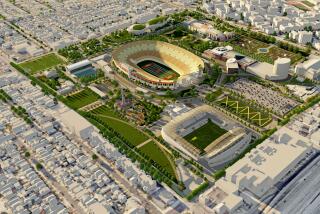PERSPECTIVE : Latest Park Equipment Puts Learning, Safety Into Play
- Share via
The changing look of municipal playgrounds has not been lost on Justin Smith.
The fifth-grader, who spends many afternoons at Seal Beach’s Marina Community Park, grimly recalls the old monkey bars that burned his hands when the summer sun heated the steel poles.
Then two years ago, the city replaced the rusting playground equipment with a colorful post-modern structure of metal, plastic and wood.
“There’s no comparison,” Justin said of the eye-catching assortment of curving slides, towers, bubble windows and ladders. “You have much more to do now. I think more kids come here to play.”
Children are responding the same way at dozens of parks across Orange County where cities have installed a new generation of playground equipment that is safer than the outdated metal variety and allows youngsters with disabilities to join in the fun.
The transformation is being prompted by several factors, including a state law that gives cities until 2000 to comply with new safety standards.
Officials said another goal is to create playgrounds that offer children more than a place to climb and slide.
The new equipment includes “mental stimulation” attractions such as spelling and tick-tack-toe games designed to help children make friends and communicate with one another.
The equipment also keeps children occupied longer than the old designs. That is important because, as enrollment increases at day-care centers and preschools, they rely more heavily on neighborhood parks for field trips.
“When you have just slides and climbing, kids go through 10 to 15 minutes of physical activity and then get worn out,” said Ron Hagan, Huntington Beach’s community services director. “The new equipment introduces other activities that keep kids entertained longer.”
Entertainment is a key component of park planning, and some officials predict that the playgrounds of the future will contain even more colorful gadgets and funky slides. They also expect more “theme” playgrounds similar in some respects to commercial attractions such as Mickey’s ToonTown at Disneyland.
*
All of that is a far cry from the nation’s first playgrounds, which had their modest beginning at the turn of the century as “sand lots” in overcrowded Eastern cities such as New York and Boston.
Suburban playgrounds have evolved over the past 50 years. In the 1950s and 1960s, park planners favored conventional monkey bars and slides made of steel.
But by the 1970s, the stark-looking bars were rusted with age and some safety experts raised concerns about children falling from towering slides and or banging their heads on the hard steel.
Eventually, the state adopted guidelines that impose equipment height limits, require playgrounds to space swings at a certain distance and call for soft ground coverings to lessen the likelihood of serious injuries.
In response, many cities started testing equipment made from old wooden telephone poles and recycled tires.
The “environmentally friendly” structures blended with the natural look of parks. But officials soon realized that wood was costly to maintain.
“With the wood structures, kids could burn it, carve it, saw it,” Hagan said. “In the 1980s, a lot more attention was paid to liability concerns, and the designs moved away from the natural materials that had a high risk.”
The latest equipment is made mostly of metal covered with a colored plastic coating. The materials are much more flexible than the wood or steel pipes, allowing designers to create unusual attractions. Some playgrounds now contain as many as five different types of slides with waves, spirals and sharp angles.
New parks also offer a wider variety of activities, such as cargo nets for climbing and “talk tubes” that allow children to communicate with each other from opposite ends of a playground.
“There is a learning process associated with them,” said Richard Mayer, Anaheim’s park planner. “It gives the kids an opportunity to communicate.”
Designers now employ terms like “imagination stations” and “activity centers” to describe their playgrounds, which provide wheelchair access and comply with the landmark 1990 Americans with Disabilities Act.
Most playgrounds are geared for 2- to 12-year-olds. But some equipment companies are marketing more sophisticated attractions for teenagers, including a tug-of-war game that sends players spinning around in circles.
Orange County park officials say they are studying the teen playground concept, but have concerns that younger children might hurt themselves on the equipment.
Some park planners and equipment manufacturers said the influence of Disneyland and other commercial entertainment will become more pronounced in tomorrow’s playgrounds.
Others hold out that hope that less flashy playgrounds will continue to thrive in the future.
“I think the solid park where kids can climb and play will always have a place,” said Deanna Manning, Irvine’s community services director.
“Kids already get a lot of stimulation from watching TV, using computers, playing video games,” Manning said. “When families come to a park, they expect a park-like atmosphere with benches and tables. I don’t see that changing a lot.”
(BEGIN TEXT OF INFOBOX / INFOGRAPHIC)
Lots More Than Sand
Playgrounds across Orange County are changing as officials comply with state safety rules and the 1990 Americans with Disabilities Act. A brief history of playgrounds:
* Early Years: Began at the turn of the century as “sandlots” in overcrowded neighborhoods of Eastern cities.
* 1940s-1960s: Designers favored monkey bars and jungle gyms made from steel poles. Later, officials raised safety concerns.
* 1970s: Wooden equipment made from old telephone poles became popular. Rustic look proved costly to maintain.
* 1980s-1990s: Cities began installing new equipment with colorful towers, bubble windows, ladders, cargo nets, tick-tack-toe games and spiral slides.
Sources: Times reports, city officials; Researched by SHELBY GRAD / For The Times
More to Read
Sign up for Essential California
The most important California stories and recommendations in your inbox every morning.
You may occasionally receive promotional content from the Los Angeles Times.














